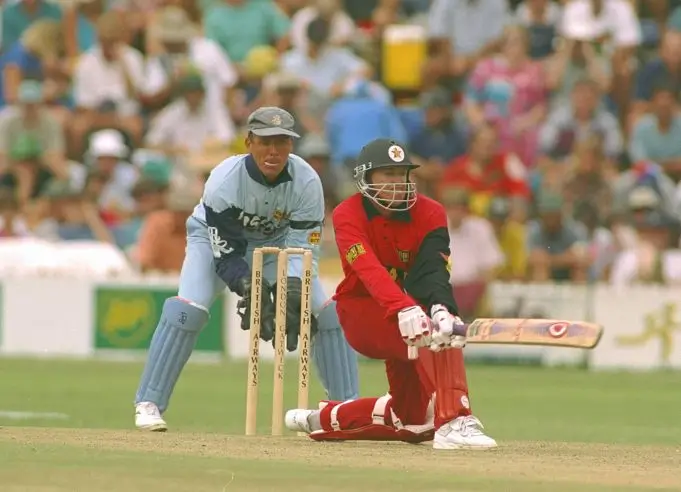The Flower brothers, Andy and Grant, were central to Zimbabwe’s cricketing success during the 1990s, a period when the nation emerged as a competitive force in international cricket. After gaining Test status in 1992, Zimbabwe relied heavily on the brothers’ exceptional skills, leadership, and consistency to achieve dominance in the era.
In the 1990s and early 2000s, Andy and Grant Flower transformed Zimbabwean cricket during a time of political turmoil. Emerging from a nation grappling with instability, they became symbols of hope as Zimbabwe earned Test status in 1992. Andy, a stylish batsman-keeper, and Grant, a resilient all-rounder, were more than athletes—they were trailblazers. Their era marked Zimbabwe’s cricketing zenith, blending skill, grit, and defiance. Though political strife cut their careers short, their legacy endures.
This article explores their journey, weaving stats with stories to reveal their impact. Beyond runs and wickets, the Flower brothers built a cricketing identity that still inspires. Their tale is one of triumph and sacrifice, showing how two siblings made Zimbabwe matter on the global stage to beat world class teams.
Igniting Zimbabwe’s Cricketing Rise

Zimbabwe’s Test status in 1992 was a landmark moment, with the Flowers at its core. Andy debuted with a rare ODI century against Sri Lanka, signaling his flair. Grant’s gritty 82 in the Test against India showcased his mettle. Their performances gave Zimbabwe instant credibility, elevating cricket from a niche sport. The 1990 ICC Trophy win, per ESPN, set the stage for Test entry, but the Flowers made it real, like England team’s recent rise.
By 1995, Grant’s unbeaten 201 and Andy’s 156 against Pakistan clinched Zimbabwe’s first Test victory, earning them the “Flower Power” moniker. Despite looming political chaos, they forged a competitive team. Their early resolve became the cornerstone of Zimbabwe’s cricketing identity against good teams.
What Set Their Debuts Apart?
Andy’s ODI ton on debut grabbed headlines, a bold statement against Sri Lanka. Grant’s Test 82 showed technical depth against India’s attack. As newcomers in an untested side, their impact was immediate, silencing skeptics, per BBC archives. Andy’s keeping complemented his batting, while Grant’s spin and fielding added versatility. Their fearlessness defined Zimbabwe’s early Test years, with a synergy that stunned opponents, like India at Paralympics.
Anchoring Zimbabwe’s Batting Core
For over a decade, the Flowers were Zimbabwe’s batting linchpins. Andy’s Test average of 51.54 rivaled the world’s best, while Grant amassed 6,571 ODI runs, often stabilizing innings. Their 12 ODI century partnerships remain a national record, per ESPN. A 269-run Test stand against Pakistan in 1995 showcased their dominance, dismantling a formidable attack.
Andy’s innovative reverse sweeps tamed spinners, while Grant’s tenacity wore bowlers down, per Wikipedia. Facing giants like Australia with a thin squad, they delivered consistently. Political disruptions never dulled their focus. Andy’s 232* against India in 2000 and Grant’s fielding brilliance cemented their stature. Together, they made Zimbabwe’s batting a global force.
How Did They Sync So Well?
Andy’s flair paired seamlessly with Grant’s composure. One pressed the attack; the other anchored. Their 269-run partnership was a lesson in balance—Andy’s aggression complementing Grant’s grit. Andy’s keeping freed Grant to bowl spin, while Grant’s sharp catches bolstered Andy’s dismissals. Their near-telepathic bond, per ESPN, baffled opponents, making them a formidable duo against strong teams.
Key Contributions of the Flower Brothers
1. Exceptional Batting Prowess
- Andy Flower: A wicketkeeper-batsman, Andy was one of the world’s best cricketers during his peak. He holds Zimbabwe’s highest individual Test score (232* against India in 2000) and was ranked the top Test batsman globally at one point. His ability to score big runs under pressure was unmatched.
- Grant Flower: A reliable top-order batsman, Grant provided stability with solid performances, including an unbeaten 201 in a Test against Pakistan in 1995. His contributions were vital in both Tests and ODIs.
2. Formidable Partnerships
The brothers’ remarkable understanding of each other’s game led to match-defining partnerships. A standout example is their 269-run stand against Pakistan in 1995—Grant scoring 201* and Andy 156—securing a historic innings victory. This remains the second-highest Test partnership for Zimbabwe and the largest by brothers in Test history.
3. Leadership and Tactical Acumen
- Andy Flower: As captain during two stints, Andy’s tactical intelligence guided Zimbabwe to significant wins, including their first Test victory against Pakistan in 1994-95. His calm leadership stabilized the team in high-pressure situations.
- Grant Flower: While not a captain, Grant’s experience as a senior player bolstered the squad’s resilience.
4. All-Round Impact
Grant’s left-arm spin and sharp fielding added versatility, while Andy’s dual role as a wicketkeeper and batsman maximized Zimbabwe’s resources. Their combined efforts provided balance and depth to the team in the timeline.
Pivotal Moments in the 90s
- 1995 Test Series vs. Pakistan: The brothers’ massive partnership led to a landmark win, showcasing their ability to dominate stronger teams.
- 1999 World Cup: Zimbabwe reached the Super Six stage, upsetting India and South Africa, with Andy among the tournament’s leading run-scorers and Grant offering crucial support.
Broader Impact
The Flower brothers were part of Zimbabwe’s 1990 ICC Trophy-winning squad, paving the way for Test status. Throughout the 90s, their consistency lifted Zimbabwe to victories against top nations, raising the country’s cricketing profile. They inspired a generation of players, with Andy’s later coaching success (e.g., leading England to Ashes wins) further highlighting his influence.
Moments That Defined Their Legacy

The 2003 protest was their boldest stand, costing their careers but winning admiration. Grant’s 201* in 1995 marked Zimbabwe’s Test arrival, while Andy’s 232* against India showcased batting mastery. Their 269-run partnership remains a record, per Wikipedia. Facing legends like Wasim Akram, they turned losses into moral victories.
Andy’s 2021 ICC Hall of Fame induction and Grant’s enduring ODI records keep their story alive. Each milestone built Zimbabwe’s cricketing pride, rooted in defiance.
Why Was the 269-Run Stand Iconic?
In 1995, Andy’s 156 and Grant’s 201* against Pakistan broke the Chappell brothers’ record, per ESPN. Leading to an innings victory, it symbolized unity and stunned the world, cementing their legend.
Stats That Showcase Their Greatness
Andy’s 4,794 Test runs and 51.54 average top Zimbabwe’s charts. Grant’s 6,571 ODI runs rank fourth nationally. Their 12 century stands are unmatched locally, per ESPN. Andy’s 151 Test catches and Grant’s 86 ODI grabs highlight their all-around impact. With over 25,000 combined international runs, they carried Zimbabwe’s hopes.
How Do Their Stats Hold Up?
Andy’s Test average rivals today’s elites, and Grant’s ODI runs dwarf current Zimbabweans. Their partnership record stands firm, per ICC data. Few siblings globally match their consistency, keeping their benchmark high.
Zimbabwe’s Decline After the Flowers

After 2004, Zimbabwe cricket plummeted. The Flowers’ exit triggered a talent exodus, worsened by political meddling, per The Guardian. The 2004 strike, led by Grant, exposed board failures, per BBC. With stars like Heath Streak gone, competitiveness faded. Funding and infrastructure collapsed, stalling new talent.
The Flowers had masked systemic flaws. Their absence revealed a broken framework. Revival began slowly around 2010, but gaps persist despite players like Sikandar Raza. Their era holds lessons for recovery.
What Triggered the 2004 Fall?
The 2004 strike protested unfair selections amid Mugabe’s interference. Grant’s leadership galvanized players, but many fled or quit. Board mismanagement accelerated the collapse, with recovery still incomplete.
Andy and Grant Flower: Career Snapshot
| Player | Tests | Test Runs | Test Avg | ODI Runs | ODI Avg | Notable Record |
|---|---|---|---|---|---|---|
| Andy Flower | 63 | 4,794 | 51.54 | 6,786 | 35.34 | 232* vs India (Test) |
| Grant Flower | 67 | 3,457 | 29.54 | 6,571 | 33.52 | 201* vs Pakistan (Test) |
Source: ESPN, ICC Archives
Conclusion
Andy and Grant Flower were the backbone of Zimbabwe’s cricketing dominance in the 1990s. Andy’s world-class batting and leadership, paired with Grant’s dependable all-round contributions, drove historic triumphs and established Zimbabwe as a formidable team. Their legacy remains a cornerstone of Zimbabwean cricket history.
Andy and Grant Flower didn’t just play cricket—they gave Zimbabwe a voice. Their talent turned a fledgling side into a contender, from Test wins to global protests. Political turmoil cut their careers short, but their influence thrives through coaching and inspiration. Zimbabwe’s cricket faded without them, yet their legacy offers a blueprint for revival. Per ICC records, no local duo rivals their impact. They proved talent could shine through chaos, remaining icons of resilience and hope for fans and players alike.

